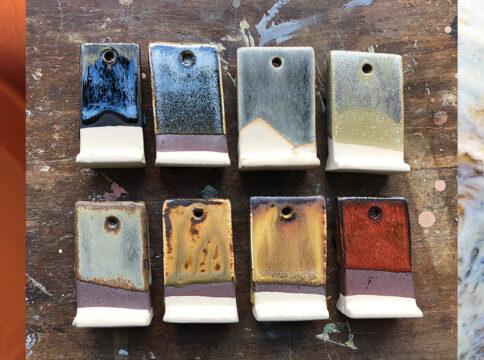
- Tutor: Jonathan Ball
- Duration: 5 days (Thur 12 to Sun 15 Oct; then Sat 28 Oct)
- Participants: 6
- Cost: €400
Lost wax kiln-casting is a versatile method for making glass pieces in almost any form imaginable. The process involves creating a refractory mold around a wax model. The wax is then removed—or “lost”—creating a cavity. Glass is cast into the cavity, resulting in a fully sculptural finished piece.
Kiln casting is a type of glass casting in which cold glass is placed over a mold inside of a kiln. The kiln is brought up to molten temperatures, causing the glass to flow into the mold. The glass object is annealed and cooled as the kiln is slowly brought back down to room temperature.
The plan of the workshop is to explore two different types of refractory molds. We will make one simple open face mold and cast a textured tile form, and one 3d mold of a smallish 3d form that is not too thin. All participants will use the same object, provided.
We will keep the object size to a kitchen roll volume and weight of glass to around 4kg each. The type of wax doesn't matter, if people want to model a 3d form from brown modeling wax, or cast a reproduction from a two part mold using micro-crystalline, it will all be able to be steamed out of the refractory mold.
Making a two-layer refractory mold of a wax original
Participants will learn how to build a mold around a sacrificial wax model. After the mold investment is set, the wax is melted out and forms a cavity where the metal or glass flows in. Using this method of casting captures fine details in both metal and glass. This ancient method has been used since 3000 B.C.
Mold Material / Investment Recipes
Participants will learn about different plaster investment recipes for making the mold. The first layer of the mold is called the face coat. The primary purpose of this layer is to pick up as much detail from the wax model as possible. The second layer of the mold is called the jacket coat. Its purpose is to give the mold strength. The jacket coat is composed of the same ingredients. Much like concrete, plaster in the investment needs to remain moist while setting up. The potential uses of using vinyl molds or algernate molds will also be explored.
Steaming out the wax
Once the mold is built, you’ll remove the wax to leave a cavity into which the glass can be cast. For kilncasting glass, steaming the wax out with a wallpaper or industrial steamer as well as microwaves will be explored. The thinner the original wax, the faster the melting process will be. Participants will wear gloves to avoid steam burns, rotate the mold to help wax escape. When no more wax runs out of the mold, they will remove it from the stand and flush it with water.
Calculating the amount of glass needed
Once the mold is cool you will measure the volume of cavity and learn how to calculate the amount of glass to be used.
Drying the Mold.
Before the mold is fired, participants will learn how to dry the mold in either a mold dryer or ambient conditions and results in a finished casting with an extremely lucid surface. Firing wet molds releases a lot of water that will attack/rust the structure of the kiln and deposit contaminants on the glass.
Preparing the kiln for firing
Participants will learn to prepare the kiln for firing taking into account three major considerations when developing a firing cycle for lost wax kilncasting:
Glass and kiln conditions
Mold materials
Timing the firing
Casting the glass into the mold
Glass casting is the process of melting glass into a mold where it solidifies and creates a glass object. Participants will learn how to set the glass above the mold for firing. Once the mold is level, it is ready to be loaded with glass. Participants will learn different technique for loading the glass including loading into a crucible above the mold.
Finishing Techniques
Finally, participants will learn how to divest the glass piece from the mold materials and go on to learn a variety of coldworking techniques to arrive at the finished piece.
Jonathan Ball
Jonathan holds a BA Honours degree in Glass Art from Edinburgh College of Art and a HND in Furniture Design and Fine Craftsmanship from Rycotewood College Oxford. He has been involved in the craft industry all his working life.Jonathan is a craftsperson who is interested primarily in the plasticity of materials. This interest has driven him to investigate and visualise how these materials can be incorporated into projects and installations in a built environment. From his studio in northwest Ireland he produces commissioned works for private and corporate clients. The ancient craft of glassblowing and forging metal are one of the studios main sources of inspiration. The acquisition and development of the skills and techniques required in theses crafts takes many years of dedication and persistence. The Leitrim based studio, has been in business for the past fifteen years and has completed a vast array of projects in Ireland and abroad. The studio offers clients a unique service and strives to produce work to the highest standards. In an age of computer generated results we visualise and create pieces that radiate the use of hand skills.




